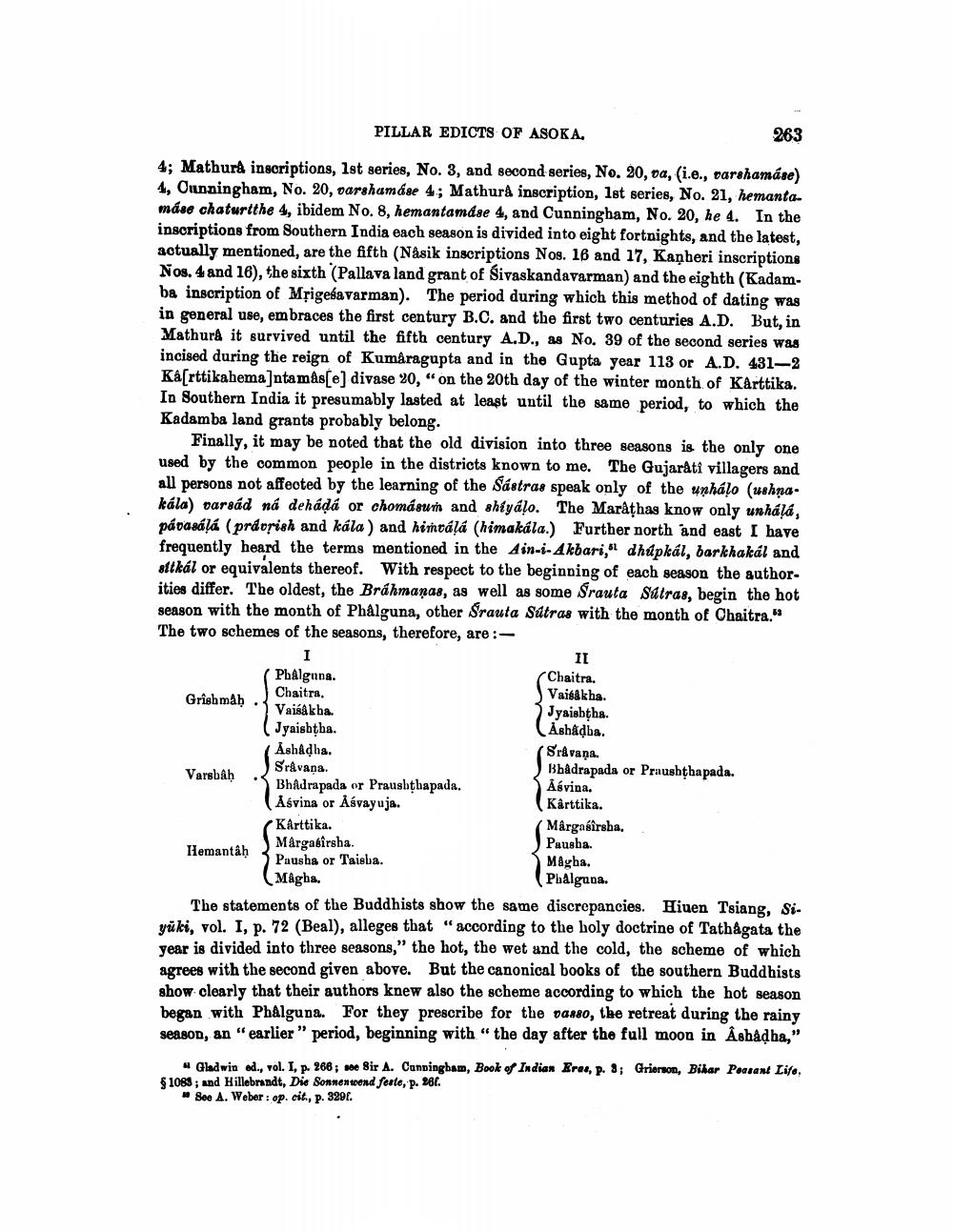________________
PILLAR EDICTS OF ASOKA,
4; Mathura inscriptions, 1st series, No. 3, and second series, No. 20, va, (i.e., varshamáse) 4, Cunningham, No. 20, varshamáse 4; Mathura inscription, 1st series, No. 21, hemantamáse chaturtthe 4, ibidem No. 8, hemantamáse 4, and Cunningham, No. 20, he 4. In the inscriptions from Southern India each season is divided into eight fortnights, and the latest, actually mentioned, are the fifth (Nasik inscriptions Nos. 16 and 17, Kanheri inscriptions Nos. 4 and 16), the sixth (Pallava land grant of Sivaakandavarman) and the eighth (Kadamba inscription of Mrigeinvarman). The period during which this method of dating was in general use, embraces the first century B.C. and the first two centuries A.D. But, in Mathurâ it survived until the fifth century A.D., as No. 39 of the second series was incised during the reign of Kumâragupta and in the Gupta year 113 or A.D. 431-2 Kâ[rttikahema]ntamas[e] divase 20, "on the 20th day of the winter month of Kârttika. In Southern India it presumably lasted at least until the same period, to which the Kadamba land grants probably belong.
Finally, it may be noted that the old division into three seasons is the only one used by the common people in the districts known to me. The Gujarati villagers and all persons not affected by the learning of the Sástras speak only of the unhálo (ushnakála) varsád ná dehádá or chomásum and shíyálo. The Marathas know only unhálá, pávasálá (právrish and kála) and himválá (himakála.) Further north and east I have frequently heard the terms mentioned in the Ain-i-Akbari, dhúpkál, barkhakál and sitkál or equivalents thereof. With respect to the beginning of each season the authorities differ. The oldest, the Brahmanas, as well as some Srauta Sutras, begin the hot season with the month of Phalguna, other Srauta Sutras with the month of Chaitra." The two schemes of the seasons, therefore, are:
Grishmâḥ
Varsbah
Hemantaḥ
I Phalguna. Chaitra.
Vaisakha.
Jyaishtha.
Ashâḍha.
Sravana.
Bhadrapada or Praushṭhapada.
Asvina or Asvayuja.
Karttika.
Mârgasîrsha. Pausha or Taisha.
Magha.
II
Chaitra.
Vaisakha.
Jyaishtha.
Ashaḍba.
Sravana.
Bhadrapada or Praushṭhapada. Åsvina.
Kârttika.
263
Märgairaha, Pausha.
Magha.
Phalgun
The statements of the Buddhists show the same discrepancies. Hiuen Tsiang, Siyüki, vol. I, p. 72 (Beal), alleges that "according to the holy doctrine of Tathagata the year is divided into three seasons," the hot, the wet and the cold, the scheme of which agrees with the second given above. But the canonical books of the southern Buddhists show clearly that their authors knew also the scheme according to which the hot season began with Phalguna. For they prescribe for the vasso, the retreat during the rainy season, an "earlier" period, beginning with "the day after the full moon in Ashâḍha,"
Gladwin ed., vol. I, p. 266; see Sir A. Cunningham, Book of Indian Eras, p. 3; Grierson, Bihar Peasant Life, §1083; and Hillebrandt, Die Sonnenwend feste, p. 261.
See A. Weber: op. cit., p. 3291.




